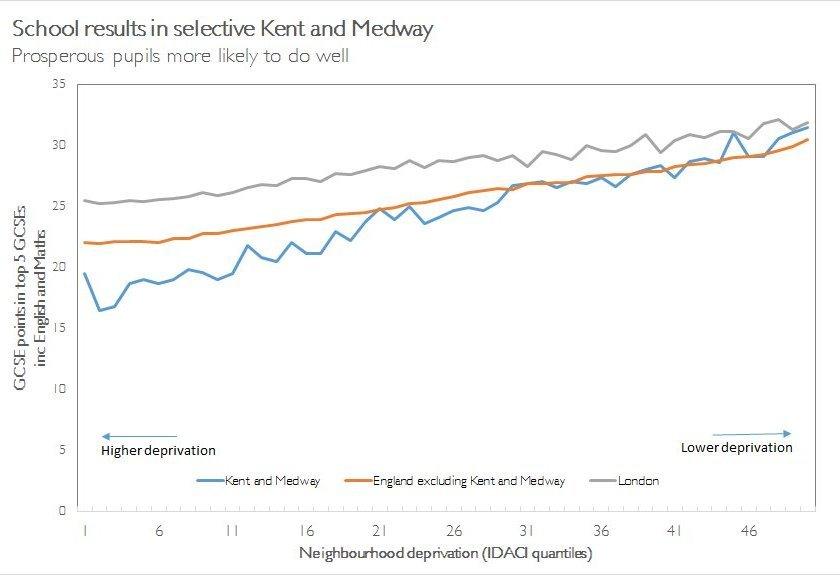Why not bring back grammar schools?
- Published

Where does the new Education Secretary Justine Greening stand on grammar schools?
Few intra-governmental memos have sparked more anger than one called Circular 10/65, a memorandum sent 51 years ago by Anthony Crosland, then the education secretary, to local authorities. The document instructed local officials to commence converting grammar schools into comprehensives. Only a few English counties, such as Kent and Lincolnshire, retained many.
Today, we learn, we have a new education secretary - Justine Greening - and she went to a comp. She is the first post-Crosland education secretary - and it has taken longer than one might have hoped for the new system to attain this position. But we also know, though, that Theresa May - and her advisers - are rather keen on a return to a world of grammars.
This might be an apt moment to quickly rattle through what we know about the grammar system. This is an argument that is, in truth, really about more than what is known, in the jargon, as "tracking" - the process of making pupils sit an academic test and separating the highest-performing from the rest.
That is because a lot of people think grammars mean high standards, neat school uniforms and strict discipline. For a lot of adults, the achievement of getting to a grammar still remains a source of pride. Lots credit their subsequent achievements to their schools in a way that presupposes (probably wrongly) they would have been crashing failures had they gone to a comprehensive.

Tony Crosland, the education secretary who issued circular 10/65
The argument about grammar schools has also acquired a political edge: grammar schools are a shibboleth for lots on the right. Conversely, lots of people who regard themselves as "progressive" tend to support comprehensive schooling. But there are actual testable claims made for grammars and comprehensives. We can examine these schools on their real merits. So we should: do they raise standards, overall? And do poorer children tend to do better in selective areas?
On one hand, selection allows for specialisation. Classes may have a less varied ability range within them. On the other hand, grouping slower learners together, we know, slows them down. And non-grammars in selective areas often struggle to recruit staff. So which forces win?
Do grammars work?
The first claim is easy to check. There is no aggregate improvement in results in areas that are wholly selective. The most important change is a clear distributional shift in who does well. In short, the minority of children streamed into the grammars do better. The remaining majority of children - who are not educated in grammars - do slightly worse.
Perhaps, you might argue, this is good. You might argue we need a distribution where we educated a minority to a higher standard and reduce the educational attainment slightly for the remainder. But at a time when much of the developed world is rushing to increase the proportion of school-leavers with post-secondary education, it would be a radical departure from educational orthodoxy.

What about the argument that grammar schools are good for social mobility? They offer, the argument goes, a private-standard education to families who cannot afford fees. But there is a serious problem with this argument: it is children from poorer backgrounds who are most likely to be dropped by the selection process.
By the time that children take the test, there is already a large educational divide. In 2013, there were 1,591 16 year-olds in still-selective Kent eligible for free school meals. Of those children, only 2% had got key stage 2 results by the age of 11 that put them in the top tenth of results for the county. A Kentish child not on free school meals would be five times more likely to achieve that feat.
So a test at 11 should, by design, select out lots of poorer children. There is a further wrinkle: the tests can be gamed, too. Parents in Kent who can afford it pay a fortune for tutors, so they can coach their children over the line. The tests, therefore, are skewed even further in favour of the county's wealthier residents.
You can see that in this graph.

I ranked all the neighbourhoods in Kent and Medway - our biggest contiguous selective area - by their prosperity. At the left hand side of this graph is the proportion of 16 year-olds in the very poorest 50th of Kent and Medway neighbourhoods who attended grammars. Disadvantage is measured using an index called the income deprivation affecting children index (IDACI). The next point in the line is the 2nd poorest, then the 3rd poorest and so on. The right hand side of the graph is the least deprived.
What you can see is that the poorest children in Kent and Medway - at the left - have a less-than-10% chance of getting into a grammar. For children in the very richest neighbourhoods, it is over 50%. This means poorer children are pressed into the non-grammars.
The end results
The overall effect of these decisions is visible in Kent's GCSE results. I have taken each child's top 5 GCSE results (from 2013), including English and maths, and turned that into a points score - from 0 points for no passes through to 40 points for 5 straight starred As. I've plotted the averages for a national scale using the same data. And, for contrast, I have included high-performing London and the rest of England.
In Kent and Medway, poorer children lag further behind, richer children move further ahead - and the losses at the bottom are much larger than the gains at the top. This is a feature of the wholly selective counties in England, as a whole. Even in the very best areas, it steepens the rich-poor gradient.

It is possible to imagine fixes to some of the problems: fixing the proportion of poorer children, for example, who get into the schools. You could also imagine a world of selective schools aimed just at the top tip of the distribution, which would in effect be special needs schools for children whose high academic attainment means they find conventional schooling difficult.
But be wary. These findings have been repeated formally time and again by researchers in different selective systems. Furthermore, the highest performing school systems in the world, according to the PISA tests, are comprehensive. So are England's highest-performing boroughs and counties - especially when you look at results for poorer children.
We made a lot of mistakes, as a country, in how we abolished the grammars. There was a twenty-year period after Circular 10/65 did its work when the old system was being dismantled but mechanisms were not put in its place to make sure children from poorer families got a fair shake. We replaced academic selection with house-price selection.
But it is hard to argue from the evidence that social mobility would be boosted by the introduction of new grammars.
- Published14 July 2016

- Published14 July 2016

- Published8 September 2016

- Published15 October 2015